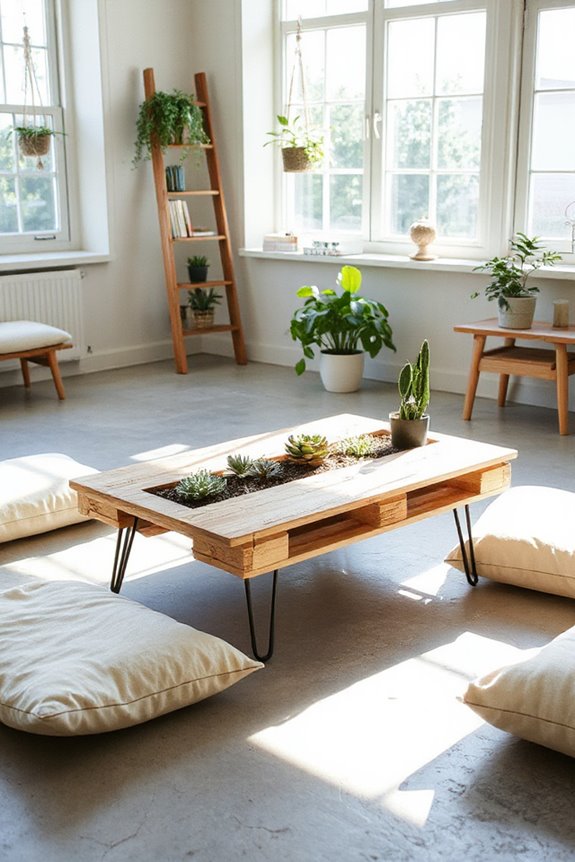Want to flip furniture from Goodwill and make some cash? Start by scouting quality pieces – look for solid wood and smooth drawers. Once you snag something, gather your tools like sandpaper and paintbrushes. Clean, repair, and give it a fresh coat of stain or varnish for that wow factor! Oh, and remember to photograph it well for your listings. Excited to transform your finds? Stick around, ’cause there’s so much more to learn about flipping success!
Key Takeaways
- Set a budget for purchasing pieces and restoration supplies, keeping overall costs low for better profit margins.
- Prioritize solid hardwood furniture with durable joints and minimal functional issues for successful flipping.
- Use essential tools like an orbital sander, screwdriver, and paintbrushes during the restoration process for quality results.
- Clean, repair, sand, and finish each piece correctly, ensuring high-quality restoration that increases resale value.
- Capture appealing photos in natural light and clean backgrounds to effectively showcase the furniture online.
Understanding Your Budget and Costs

When you’re immersing yourself in the world of flipping furniture from Goodwill, understanding your budget and costs is key—don’t you want to make sure you’re not spending more than you’re earning? Start with the initial purchase price, which typically ranges from $10 to $50. Look out for those sweet discounts on certain days, too!
Now, don’t forget a cost analysis for restoration. You’ll need supplies like paint and sandpaper that can set you back another $50 to $100. Plus, can you spare a little for tools? Allocating funds effectively helps beat those budget limitations. Additionally, consider investing in high-quality materials to enhance the final product and increase resale value. And remember, evaluating the condition of each piece will help you determine your potential profit. Ready to jump in? Let’s flip!
Selecting the Right Furniture Pieces
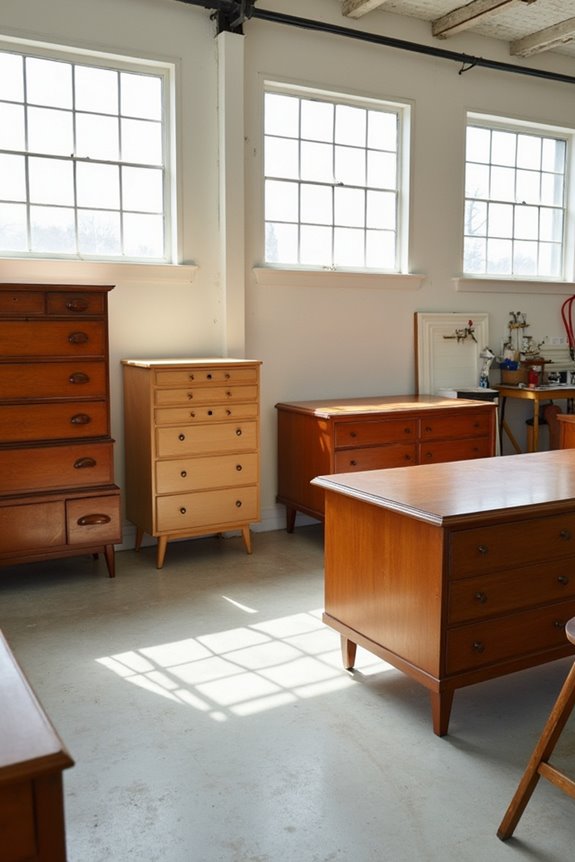
You’ve got your budget set, and now it’s time to choose the right furniture pieces to flip! Start with a durability assessment—solid hardwoods like oak and maple are your best pals. Check those joints too! Screwed or dowelled joints are way better than flimsy ones.
Next, move on to an aesthetic evaluation. Does the style vibe with your decor dreams? Look for unique details that make your piece pop! Color matters, too; can it be easily updated? Sofas with solid hardwood frames ensure durability and longevity, making them ideal candidates for flipping.
Don’t forget to inspect for functional issues. Open those drawers—do they glide smoothly?
In the end, picking furniture isn’t just about luck; it’s about knowing what to look for! Happy hunting, and may your flip be fab!
Essential Tools and Materials for Restoration
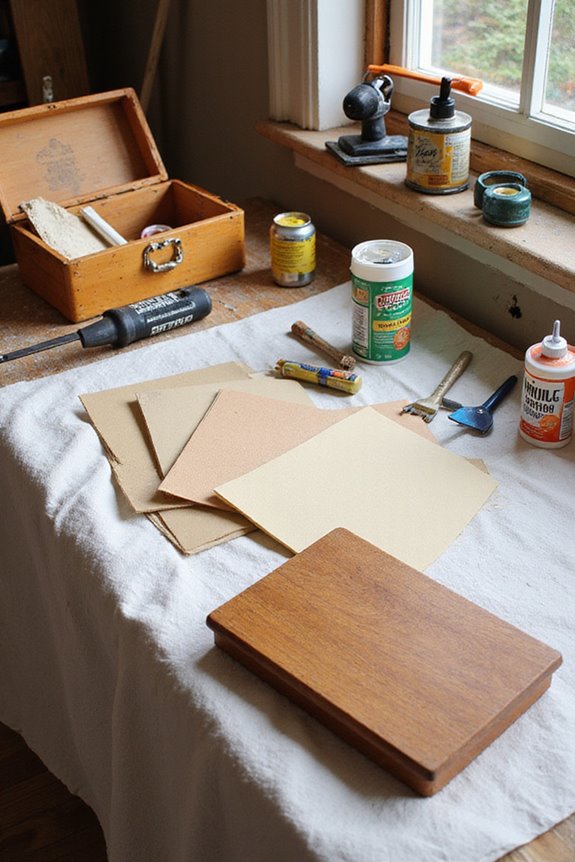
As you immerse yourself in the world of furniture restoration, gathering the right tools and materials can make all the difference in your flipping adventure! Start with your tool selection—a trusty orbital sander and a variety of sandpaper discs are essential. Don’t forget a screwdriver set for disassembly; you wouldn’t want to be stuck mid-project, right?
For material sourcing, grab paintbrushes or rollers for that smooth finish, plus some wood stain in your favorite color. You’ll also need drop cloths to protect your space. And safety first—goggles and a mask are a must! With this setup, you’re ready to immerse yourself and transform those thrift store finds into fabulous pieces. Additionally, consider incorporating vintage filing cabinets as they can dramatically upgrade your home office aesthetics. What are you waiting for? Let’s get started!
Step-by-Step Restoration Process
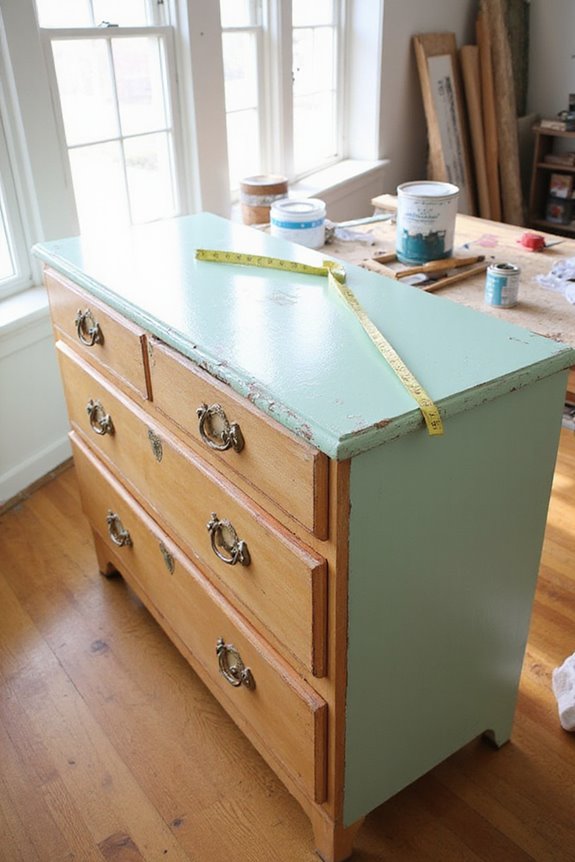
Ready to transform that Goodwill find into a show-stopping masterpiece? First, let’s get down to the cleaning techniques! Use dish soap and warm water to scrub away dirt. Who knew cleaning could be so easy? Next, check for any damages. Got cracks or loose pieces? Time for some wood filler and glue—this part is essential!
Once you’ve stabilized everything, it’s sanding time! Use sandpaper to smooth those surfaces—trust me, you want this part to be perfect. With everything nice and smooth, choose your finishing option. Will it be a bold stain or a sleek varnish? The choice is yours! Remember, patiently let those finishes dry completely before showing off your fabulous flip. Happy restoring!
Creative Design Techniques to Enhance Appeal
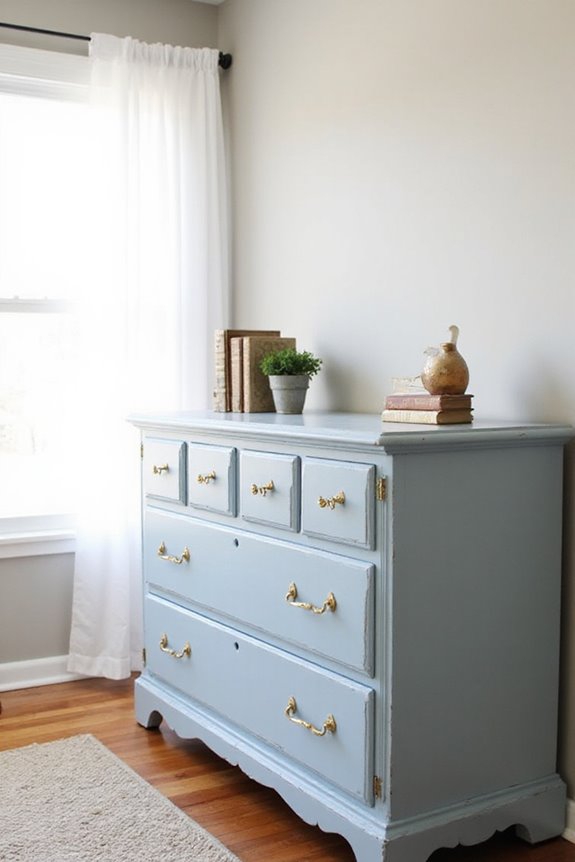
When you think about giving your Goodwill furniture a fresh new look, it’s not just about slapping on a coat of paint. Why not explore color contrast to draw attention to unique features? You could try some fun stencil designs for a contemporary vibe!
Want to kick it up a notch? Layered effects can add depth and personality. And don’t forget distressed finishes—they provide that trendy vintage charm everyone loves.
Ready to transform? Imagine a bold fabric pattern on the cushions paired with that stylish paint job! You’ll have a unique piece that’s not only beautiful but also tells a story. So, roll up your sleeves and get creative! Your furniture flip awaits! 🎨✨
Effective Photography Tips for Selling
You’ve worked hard to flip that Goodwill furniture, and now it’s time to show it off! First, play with photography angles. Capture your piece from the front, side, back, and even top-down. This helps buyers visualize dimensions and unique details. Have you ever thought about using close-ups? They really highlight your furniture’s charm!
Next, let’s talk lighting techniques. Natural light is your friend! It showcases colors and textures without harsh shadows. Keep your backdrop clean—white or neutral works best. Ever tried using props for staging? They suggest how to use the piece in a room!
With clear, bright images, you’ll build buyer confidence and boost those sales. Are you ready to capture that beauty? Let’s get snapping!
Pricing Your Flipped Furniture Competitively
Finding the sweet spot for pricing your flipped furniture can feel a bit like a treasure hunt! First, check out the market demand for similar items. You don’t want to price too high or too low. Have you done a competitor analysis on platforms like eBay and Facebook Marketplace? It’s essential to see what others charge for similar pieces.
Next, calculate your total costs, including your original purchase price and any refurbishing materials. Aim for a profit margin of 40-60%—it’s achievable! And don’t forget to adjust your prices based on buyer feedback or market trends. Flexibility is key! By being strategic, you can boost your profits and keep your flipping journey exciting! Ready to hunt for that perfect price?
Promoting and Selling on Multiple Platforms
If you want to make the most of your furniture flipping adventure, promoting and selling across various platforms is essential! Start with social media promotion. A Facebook Marketplace listing can attract buyers both locally and beyond. Ever tried creating an Instagram page? It’s perfect for showcasing your stunning pieces before listing them! Don’t forget TikTok; it’s a great spot for fun, engaging videos.
Now, how about online marketplaces? Etsy and Craigslist are popular options, though be ready for fees and lowball offers. Also, consider niche sites like Upflip. Finally, always post consistently. Regular updates keep your audience enthusiastic. So, what are you waiting for? Plunge into those platforms and watch your sales soar! 🌟
Frequently Asked Questions
How Do I Recognize High-Quality Furniture at Goodwill?
When you’re recognizing high-quality furniture, focus on solid wood, unique design styles, and durable materials. Check for sturdy construction, proper joinery, and quality upholstery; these signs indicate a piece worth your investment and time.
What Types of Furniture Sell Best After Flipping?
Imagine a treasure hunt; vintage style and mid century modern pieces like dressers and buffets shine like gold. They’re in high demand, making your flips not just profitable, but a delightful journey for buyers seeking unique charm.
How Can I Determine the Repair Cost Before Buying?
To determine repair costs, conduct a damage assessment for visible issues, then seek an accurate repair estimation. Consider material types and extent of damage, as these factors greatly influence your overall costs. Compare quotes for better value.
Are There Specific Brands to Look for When Selecting Furniture?
When you’re hunting for that perfect piece, consider mid-century modern brands like Herman Miller and vintage styles from Cassina. They’re treasures that can transform your space and offer strong resale potential, turning heads in any room.
What Time of Year Is Best for Reselling Flipped Furniture?
The best time for reselling flipped furniture is during seasonal trends, especially summer and fall when home renovations peak. Holiday demand also surges, so focus on dining pieces for that festive season excitement.



